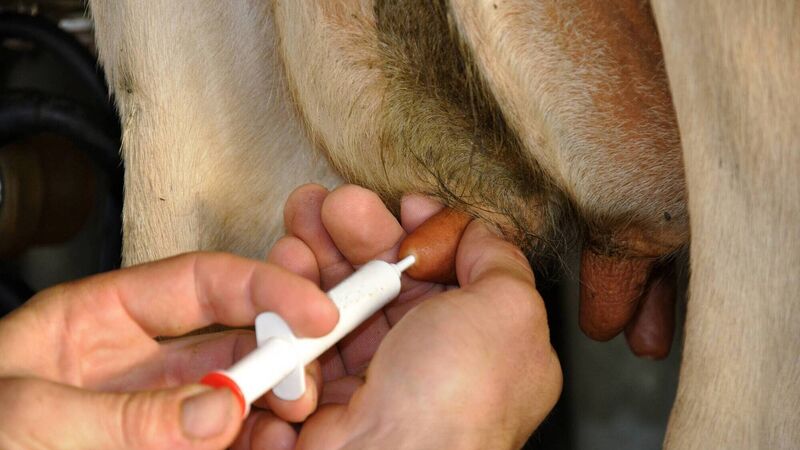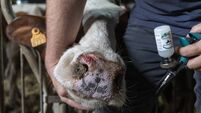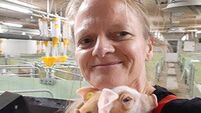Use cow-level data for dry-off success

Vets will be expected to only prescribe antibiotics where there is evidence of its requirement, according to Dr Stuart Childs of Teagasc.
“Vets will be expected to only prescribe antibiotics where there is evidence of its requirement”, said Dr Stuart Childs of Teagasc, when he hosted a recent edition of Teagasc’s Dairy Edge podcast on selective dry cow therapy.
He was speaking to Teagasc mastitis researcher Dr Pablo Silva Boloña about the EU regulation of veterinary medicinal products, which no longer permits blanket treatment of cows with antibiotics at dry-off to prevent infections in the dry period.
The alternative is selective dry cow therapy, treating uninfected cows at dry-off with an internal teat sealant, which acts as a physical barrier preventing the entrance of bacteria to the udder.
Dr Boloña has carried out extensive research on commercial dairy farms. He said: “In some herds, we have found there is no negative impact of using teat sealant alone, compared to antibiotic plus teat sealant, in lower SCC cows, whereas in others it has resulted in higher somatic cell count in the following lactation and higher infection levels”.
He said the difference from herd to herd is due largely to their management in the dry period and early lactation.
He said the previous blanket usage of intramammary antibiotics at dry-off was effective in treating existing infections, and helping to prevent new infections over the dry period. But antibiotics can no longer be used as a preventative measure.
Now, the rule is “selectively assigning antibiotics to cows that actually have an infection at the end of their lactation”.
The objective of the EU legislation is to lower the use of antibiotics, not to eliminate their use.
Cow-level information is now required by vets. If there is evidence that the cow has an infection requiring antibiotics, the vet can prescribe them. Vets can base their decision on milk recording and milk quality data, and the records of recent clinical cases. If such information is not available, vets can use the California mastitis test for subclinical mastitis, to identify infected quarters.
“Milk recording is the most useful and easy-to-get piece of information, and it strikes the right balance of reliability and ease of getting it, compared to the other methods”, said Dr Boloña. “Definitely, if the farmers can, they should do milk recording”.
“Using the last milk recording of the lactation is a good tool to decide which cows should get antibiotic plus teat sealant, and which cows should get teat sealant alone”.
Dr Boloña's research also identified the SCC threshold at which to select cows for antibiotic treatment. “From our studies, it turns out that for older cows it’s somewhere around 100,000, and for younger cows, it can be slightly lower, around 65,000”.
If not habitually milk recording, farmers should consider doing at least one towards the end of the lactation, within 30 days of drying off. This will be very useful when deciding which cows need antibiotic treatment.
“The more milk recordings, the better, in terms of mastitis management and in making decisions on whether to cull or to keep cows in the herd”.
“First of all, the drying off procedure needs to be as clean as possible, making sure that cows’ teats are properly clean, especially if they’re going to be treated with teat sealant alone. The level of cleanliness needs to be clinical - almost surgical”, he said.
His research indicated that particularly high yielding cows (just before dry-off) may be more at risk when treated with only teat sealant, so strategies to reduce their yield before dry off are advisable. Do not reduce high yields by milking once a day, Dr Boloña recommended using diet instead.
If dry-off is not done correctly (very hygienically), cows might become infected, with bacteria entering the teats with the teat sealant. The sealant must cover the base of the teat and the teat end to prevent bacteria moving up the mammary gland. The sealant must remain in the bottom of the teat.
Dr Boloña said it’s readily feasible to implement selective dry cow therapy with very positive outcomes. “We saw that even when farmers were selecting the cows using a 200,000 cut-off point for SCC, some farmers did quite well. There was no negative impact of using only teat sealant in the following lactation, so it’s very possible if management is on point”.
“Success I would see as reducing the use of antibiotics and also not seeing a negative impact in the following lactation on your bulk tank SCC and on your clinical cases.
“In our studies, where we surveyed more than 20 commercial farms, there were farmers that were doing over 80% of the cows with teat sealants alone, they didn’t have problems in the following lactation, and the bulk tank SCC was always under 200,000”.
“Farmers who were cleaning and liming cubicles twice per day had lower SCC counts in the following lactation compared to farmers that were doing it just once per day”.
If cubicles are over-stocked, they will be much harder to keep clean.
“Around calving, if you can prevent mixing of heifers with older cows, that can be important... Older cows are a reservoir for Staph aureus in particular."
Milkers’ hands and cows’ teats should be kept as clean and dry as possible (while milking). Correctly applying post-milking teat disinfection is most effective in preventing the spread of Staphylococcus aureus.
In the commercial herds, a high level of infection was found in first lactation cows, late in the lactation.
“We were very surprised to see that”, said Dr Boloña. If infected, especially with Staphylococcus aureus, they get off to a bad start, and risk retaining that bacterium for their lifetime, as well as passing it to other cows.
“We think most of those originated early on in the lactation”, he said. “These are animals that are still growing, still developing. Their immune system has not been fully developed. It hasn’t been fully challenged by bacterial exposure, and when they’re transitioning from the late pregnancy period to the early lactation period, they are subject to high levels of stress, a lot of changes in their physiology and everything, which makes them more vulnerable to infection. Their immunity is definitely reduced compared to older cows”.
In most Irish herds, older cows are managed together with heifers at calving and in the early lactation, which may explain subsequent high infection rates in first lactation cows. In other parts of the world, heifers are managed as a separate group.
“Anything that the farmer can do to prevent infection coming from older cows to younger cows is something that could reduce the risk”, advised Dr Boloña. Cross contamination from the cluster, or the milker’s hands, is possible if a first lactation cow is milked immediately after an infected older animal.
For cows not given antibiotics for the dry period, calving and early lactation management are very important. It is in the two weeks before and after calving that cows and heifers pick up the majority of their infections.












